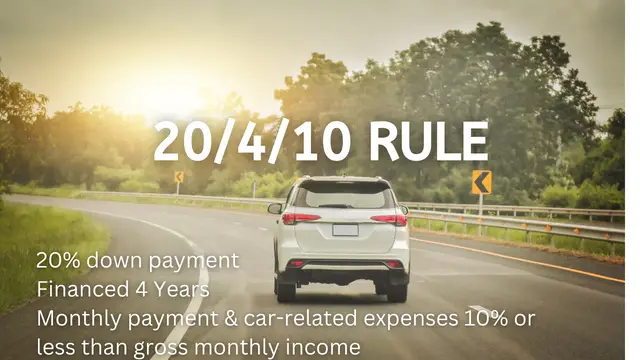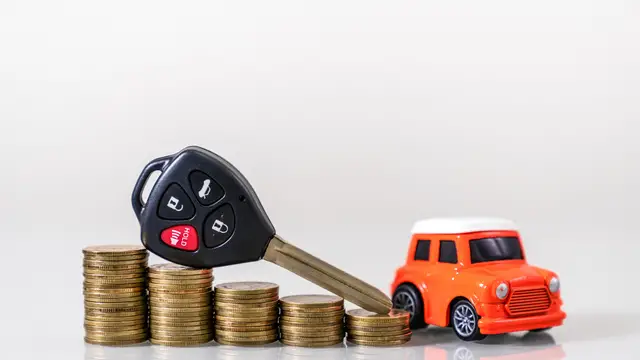This post may contain affiliate links; please see our disclaimer for details.
If you’re in the market for a new car, you may wonder how to go about it. Don’t sweat it; we’re here to help.
Of course, we recommend buying a reliable car with cash if possible, but we also understand that buying a car is a big purchase. So following the 20/4/10 rule can help you in many ways.
Table of Contents
What is the 20/4/10 rule?

The 20/4/10 rule for buying a car means putting 20% towards the down payment, financing the vehicle for no more than four years, and keeping your monthly car payment and all car-related expenses at 10% or less of your gross monthly income.
So not too complicated, right? Still, I want to explain it further and provide some examples.
The 20% Down Payment
Ideally, you should put down at least 20% of the car’s purchase price as a down payment.
However, if you can’t swing that, don’t worry! – you can still follow the 20/4/10 rule.
You’ll have to finance the car for longer (more on that in a minute).
The reason it’s best to put down 20% is twofold:
- It will help you get a lower interest rate on your loan.
- You won’t be upside down on your loan – you won’t owe more than the car is worth.
If you put down less than 20%, you may be required to purchase gap insurance. This insurance covers the difference between what you owe on your loan and the car’s actual cash value if it’s totaled in an accident.
The 4-Year Loan Term

Once you’ve figured out how much you can put down, it’s time to look at the loan itself. The 20/4/10 rule says you should finance your car for no more than four years if possible.
You may be thinking why four years? For one thing, the longer your loan term, the more interest you’ll pay. So the money that would have gone to extra payments could stay safely into your pocket, not the banks.
Credit Karma says the average loan length is 72 months or 6 years for those with high credit scores. Having a 20% down payment and great credit will go a long way to help you obtain a 4-year loan.
If you’re interested in learning methods to improve your credit score, you can always check out this article I wrote – 13 Genius Tips to Boost Your Credit Score (Fast!). 🙂
Remember that a shorter loan term will help you pay off your car sooner. And that’s a good thing because once your car is paid off, you’ll have one less monthly payment to worry about – woohoo!
Monthly payment of 10% or less than your gross monthly income
Let’s break down the 10% part of the 20/4/10 rule: keeping your monthly car loan payment and all car-related expenses 10% or less than your gross monthly income.
This part takes some basic math, but it’s essential to get it right.
The goal is not to have the car payment consume more than 10% of your gross monthly income. So let’s say you make $3,000 per month; you shouldn’t spend more than $300 per month on your car payment and related expenses such as gas, oil changes, and repairs.
Make sure you take into account any other debt accounts you may have. If you already have a significant monthly debt payment, you may want to go even lower than 10%.
Just a side note, life can be difficult when you get into too much debt. So I wrote this article that can hopefully help those trying to get out of debt: 11 Strategies to Get Out of Debt Fast!
If you are struggling with debt, remember the hardest part is starting, but you can definitely become debt free with time and effort.
Why the 20/4/10 Rule of Thumb Generally Works
The 20/4/10 rule is a great guideline to follow when buying a car. But why does it work so well?
For one thing, it compels you to be realistic about your budget.
Many people get in over their heads when buying a car because they’re not mindful of how much they can afford. The 20/4/10 rule takes the guesswork out of the equation.
Another reason the 20/4/10 rule is effective is that it helps you avoid being upside down on your loan.
As mentioned earlier, being upside down on your loan means you owe more than the car is worth.
This can happen if you put very little money down or finance the car for a longer period. It’s a situation you want to avoid because if you total your car, you could be stuck paying off a loan for a car that no longer exists.
The 20/4/10 rule is also an excellent way to keep your monthly car payments in check.
By capping your car payment at 10% of your monthly income, you’ll ensure that it doesn’t become a financial burden.
Of course, the 20/4/10 rule is just a guideline. You may be able to put down more than 20% or finance your car for a shorter term and still stay within your budget.
But if you’re not sure where to start, the 20/4/10 rule is a great place. It’ll help you stay financially responsible and avoid getting in over your head.
As with anything in life, there are pros and cons to the 20/4/10 rule.
Pros Of The 20/4/10 Rule

It Forces You To Be Realistic
The first and most obvious pro is that it forces you to be realistic about what you can afford.
It’s easy to think you can afford a luxury car when all you can afford is a beater, but the 20/4/10 rule doesn’t allow that thinking.
It gets You Out Of Debt Quicker
Another pro is that it gets you out of debt quicker. By capping your loan at four years, you’ll be debt-free sooner than if you had a longer loan.
Nothing is better than being debt-free, so this is a pro.
Avoids Negative Equity
The 20/4/10 rule also helps you avoid negative equity. As mentioned earlier, negative equity is when you owe more on your loan than the car is worth.
This can happen if you put very little money down or finance the car for the long term. And it’s a situation you want to avoid because owing more than something is worth just plain stinks!
Keeps Monthly Payments In Check
Finally, the 20/4/10 rule keeps your monthly payments in check. By capping your car payment at 10% of your monthly income, you’ll ensure that it doesn’t become a financial burden.
This is a big deal because a lot of people get in over their heads by financing a car they can’t really afford.
Cons Of The 20/4/10 Rule
It’s Only A Rule Of Thumb
The first and most obvious con is that it’s only a rule of thumb. There’s nothing magical about the 20/4/10 rule that makes it the perfect car-buying strategy.
It’s just a guideline that works well for most people and is a great starting point.
It Doesn’t Take Into Consideration Other Debt
Another con is that the 20/4/10 rule doesn’t consider other debt accounts.
This rule will be difficult to follow if 50% of your monthly payments are tied up in debt payments. It’s important to have enough cash flow and reduce overall debt.
It May Not Be Feasible
The final con is that the 20/4/10 rule may not be feasible for everyone.
For example, if you have a low income or poor credit, you may not be able to get a loan with such favorable terms.
Not everyone has great or good credit, so this is a con.
Why You Need a Budget Before Buying a New Vehicle
Some may wonder why you need a budget before shopping for a new vehicle. After all, can’t you shop around and buy whatever car you think will look cool?
Well, everyone wants to look cool, but the problem is that many people can’t afford the cars they want. And that’s why having a budget is so important.
For my wife and me, having a car is a need. Anything extra that is fancy or above average is what we consider a want and unnecessary right now.
Having a budget allows you to be realistic about what you can afford. It takes all of the emotions out of car buying and helps you think with your head instead of your heart.
And that’s a good thing because, as we all know, emotions can lead to bad decision-making. You see, many people get in over their heads when they finance a car they can’t afford.
Creating a budget may not be the most pleasant thing if you’re unhappy with your finances, but it’s a necessary evil.
Think of it this way, would you rather be unhappy with your finances for a while or be unhappy with your finances for a long time?
The answer is obvious, so get to work on creating a budget! You’ve got this!
Conclusion
Owning a car is a big financial responsibility, so make sure you’re prepared before you sign on the dotted line.
The 20/4/10 rule can be an excellent rule of thumb when buying a car. It’s simple, and it works for many people.
Just remember to think of the 20/4/10 rule as a guideline, not a hard and fast rule. It’s okay to be flexible.
By taking a good hard look at the 20/4/10 rule, you’re well on your way to being a smart and responsible car buyer.
Disclaimer:
We hope the information in this article provides valuable insights to every reader but we, the Biesingers, are not financial advisors. When making your personal finance decisions, research multiple sources and/or receive advice from a licensed professional. As always, we wish you the best in your pursuit of financial independence!

